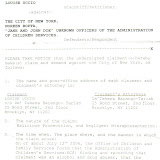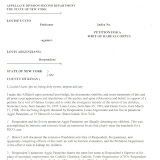 Louis J. Eppolito, left, and Stephen Caracappa were described as committing “despicable crimes of violence and treachery.”
Louis J. Eppolito, left, and Stephen Caracappa were described as committing “despicable crimes of violence and treachery.”The Story Below only appears to be unrelated to my typical blogs- In fact it's very related--most of the cases I've followed including mine could/would fall under RICO cases if it weren't criminals in black robes doing the crimes!
The racketeering convictions of two retired New York City detectives who helped to kill at least eight men in their role as mob assassins were ordered reinstated on Wednesday by a federal appeals court. It ruled that a trial judge wrongly overturned the jury’s guilty verdicts two years ago.
The decision means that the two highly decorated detectives — Louis J. Eppolito and Stephen Caracappa — will now face sentencing for their convictions in one of the most spectacular cases of police corruption in city history.
The two men seem certain to spend the rest of their lives in prison. In 2006, after they were convicted of racketeering conspiracy, the trial judge, Jack B. Weinstein of United States District Court in Brooklyn, issued but did not officially impose life prison sentences for each man.
Then, saying the five-year statute of limitations for racketeering had run out, the judge overturned the convictions despite what he called “overwhelming evidence” that the two men were “heinous criminals” who were guilty of the “most despicable crimes of violence and treachery.”
But in a 70-page opinion released on Wednesday, a three-judge panel of the United States Court of Appeals for the Second Circuit, in Manhattan, concluded that Judge Weinstein’s view of the conspiracy was too narrow, and that it had continued to exist within five years of when the men were charged.
Although murders and other serious crimes that the men were accused of occurred in Brooklyn in the 1980s and 1990s, prosecutors used more recent and less serious charges — money laundering and narcotics distribution in Las Vegas in 2004 and 2005 — to bring the earlier acts under the umbrella of an ongoing criminal enterprise.
Judge Weinstein, in throwing out the men’s convictions, had found that the recent crimes were “singular, sporadic acts of criminality,” and could not be considered part of the earlier conspiracy, which included kidnapping, bribery and obstruction of justice. Because the older crimes dated back more than five years, the men, thus, could not be prosecuted for them.
“The government’s case against these defendants stretches federal racketeering and conspiracy law to the breaking point,” Judge Weinstein wrote.
Judge Weinstein had also decided that the earlier conspiracy ended when the two detectives retired and left the New York area and other co-conspirators were arrested.
But Judge Amalya L. Kearse, writing for the appellate panel, said Judge Weinstein’s views of the criminal enterprise were too restrictive, given the evidence presented at the trial.
For example, Judge Kearse said, even after the two detectives retired in the early 1990s, one gave his pager number to Burton Kaplan, a former associate of the Luchese crime family who was the government’s key witness and testified about the services that both detectives had provided to organized crime.
She said the appeals panel concluded that the criminal enterprise had not ended before 2000, and thus the prosecution was not disallowed. Joining in the decision were Judges Robert D. Sack and Peter W. Hall.
Benton J. Campbell, the United States attorney in Brooklyn, whose office had appealed the case, said: “We are gratified by the decision of the Court of Appeals reinstating the jury verdict against the two defendants, who can now be sentenced for the extremely serious crimes that they committed.”
A police spokesman had no comment. Lawyers for each of the two men, who have been held without bond, did not respond to phone messages seeking comment.
Prosecutors charged that the two men, who both joined the police force in 1969, had taken thousands of dollars to carry out the mob murders and to leak law enforcement information, disclosing the identities of witnesses and compromising investigations.
In the first of the mob killings, in 1986, the two detectives, driving in an unmarked police car and using a siren, pulled a jeweler named Israel Greenwald over on a Long Island road, according to a government brief summarizing the trial testimony.
The detectives told Mr. Greenwald that he was needed in a lineup concerning an automobile accident. They then drove him to a garage, where he was shot to death.
Prosecutors said the detectives had first offered their services to Mr. Kaplan through a cousin of Mr. Eppolito’s who was also a mobster.
Mr. Kaplan entered into an agreement with the detectives to pay them regularly.
“The defendants were paid $4,000 a month for information, and tens of thousands of dollars for murders and kidnappings,” the government brief said.
At the trial, the jury also found that the men murdered a capo in the Gambino family in his Mercedes-Benz on the Belt Parkway; and that they kidnapped a Staten Island man, put him in a trunk, and delivered him to another mobster who tortured him for hours before killing him.
Judge Kearse, in the decision, cited the payments to the detectives as one factor that supported the prosecution’s view that the conspiracy spanned the entire period of the indictment, from 1979 to 2005.
She said that the jury had been told the principle purpose of the enterprise, as the indictment charged, was to generate money for the detectives, through legal and illegal activities.
Judge Kearse also noted that prosecutors had told the jury that the two men had “received money for each crime in New York, and they broke the law for money in Las Vegas.”
Thus, she ruled, the jury could have inferred that the conduct was “sufficiently similar in purpose” to show that “the enterprise that began in New York continued to exist in Las Vegas.”
Link - Convictions Reinstated in Mob Case - NYTimes.com
The racketeering convictions of two retired New York City detectives who helped to kill at least eight men in their role as mob assassins were ordered reinstated on Wednesday by a federal appeals court. It ruled that a trial judge wrongly overturned the jury’s guilty verdicts two years ago.
The decision means that the two highly decorated detectives — Louis J. Eppolito and Stephen Caracappa — will now face sentencing for their convictions in one of the most spectacular cases of police corruption in city history.
The two men seem certain to spend the rest of their lives in prison. In 2006, after they were convicted of racketeering conspiracy, the trial judge, Jack B. Weinstein of United States District Court in Brooklyn, issued but did not officially impose life prison sentences for each man.
Then, saying the five-year statute of limitations for racketeering had run out, the judge overturned the convictions despite what he called “overwhelming evidence” that the two men were “heinous criminals” who were guilty of the “most despicable crimes of violence and treachery.”
But in a 70-page opinion released on Wednesday, a three-judge panel of the United States Court of Appeals for the Second Circuit, in Manhattan, concluded that Judge Weinstein’s view of the conspiracy was too narrow, and that it had continued to exist within five years of when the men were charged.
Although murders and other serious crimes that the men were accused of occurred in Brooklyn in the 1980s and 1990s, prosecutors used more recent and less serious charges — money laundering and narcotics distribution in Las Vegas in 2004 and 2005 — to bring the earlier acts under the umbrella of an ongoing criminal enterprise.
Judge Weinstein, in throwing out the men’s convictions, had found that the recent crimes were “singular, sporadic acts of criminality,” and could not be considered part of the earlier conspiracy, which included kidnapping, bribery and obstruction of justice. Because the older crimes dated back more than five years, the men, thus, could not be prosecuted for them.
“The government’s case against these defendants stretches federal racketeering and conspiracy law to the breaking point,” Judge Weinstein wrote.
Judge Weinstein had also decided that the earlier conspiracy ended when the two detectives retired and left the New York area and other co-conspirators were arrested.
But Judge Amalya L. Kearse, writing for the appellate panel, said Judge Weinstein’s views of the criminal enterprise were too restrictive, given the evidence presented at the trial.
For example, Judge Kearse said, even after the two detectives retired in the early 1990s, one gave his pager number to Burton Kaplan, a former associate of the Luchese crime family who was the government’s key witness and testified about the services that both detectives had provided to organized crime.
She said the appeals panel concluded that the criminal enterprise had not ended before 2000, and thus the prosecution was not disallowed. Joining in the decision were Judges Robert D. Sack and Peter W. Hall.
Benton J. Campbell, the United States attorney in Brooklyn, whose office had appealed the case, said: “We are gratified by the decision of the Court of Appeals reinstating the jury verdict against the two defendants, who can now be sentenced for the extremely serious crimes that they committed.”
A police spokesman had no comment. Lawyers for each of the two men, who have been held without bond, did not respond to phone messages seeking comment.
Prosecutors charged that the two men, who both joined the police force in 1969, had taken thousands of dollars to carry out the mob murders and to leak law enforcement information, disclosing the identities of witnesses and compromising investigations.
In the first of the mob killings, in 1986, the two detectives, driving in an unmarked police car and using a siren, pulled a jeweler named Israel Greenwald over on a Long Island road, according to a government brief summarizing the trial testimony.
The detectives told Mr. Greenwald that he was needed in a lineup concerning an automobile accident. They then drove him to a garage, where he was shot to death.
Prosecutors said the detectives had first offered their services to Mr. Kaplan through a cousin of Mr. Eppolito’s who was also a mobster.
Mr. Kaplan entered into an agreement with the detectives to pay them regularly.
“The defendants were paid $4,000 a month for information, and tens of thousands of dollars for murders and kidnappings,” the government brief said.
At the trial, the jury also found that the men murdered a capo in the Gambino family in his Mercedes-Benz on the Belt Parkway; and that they kidnapped a Staten Island man, put him in a trunk, and delivered him to another mobster who tortured him for hours before killing him.
Judge Kearse, in the decision, cited the payments to the detectives as one factor that supported the prosecution’s view that the conspiracy spanned the entire period of the indictment, from 1979 to 2005.
She said that the jury had been told the principle purpose of the enterprise, as the indictment charged, was to generate money for the detectives, through legal and illegal activities.
Judge Kearse also noted that prosecutors had told the jury that the two men had “received money for each crime in New York, and they broke the law for money in Las Vegas.”
Thus, she ruled, the jury could have inferred that the conduct was “sufficiently similar in purpose” to show that “the enterprise that began in New York continued to exist in Las Vegas.”
Link - Convictions Reinstated in Mob Case - NYTimes.com























No comments:
Post a Comment